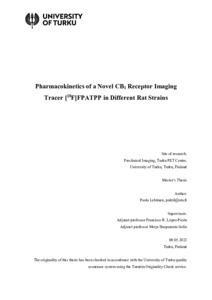Pharmacokinetics of a Novel CB1 Receptor Imaging Tracer [18F]FPATPP in Different Rat Strains
Lehtinen, Paula (2023-05-10)
Pharmacokinetics of a Novel CB1 Receptor Imaging Tracer [18F]FPATPP in Different Rat Strains
Lehtinen, Paula
(10.05.2023)
Julkaisu on tekijänoikeussäännösten alainen. Teosta voi lukea ja tulostaa henkilökohtaista käyttöä varten. Käyttö kaupallisiin tarkoituksiin on kielletty.
avoin
Julkaisun pysyvä osoite on:
https://urn.fi/URN:NBN:fi-fe2023060552562
https://urn.fi/URN:NBN:fi-fe2023060552562
Tiivistelmä
The endocannabinoid system is an internal regulatory system in humans that plays a role in several diseases, including neurodegenerative disorders. It consists of endocannabinoids, enzymes, and two types of cannabinoid receptors, CB1R and CB2R. This study aimed to investigate the pharmacokinetics of a new CB1R-specific positron emission tomography (PET) radiotracer called [18F]FPATPP, developed at the Turku PET Centre, in male and female rats of four different strains using both in vivo PET and computerized tomography (CT) imaging, and ex vivo brain autoradiography.
The experiment used male and female rats aged two to three months from the Fischer344, Sprague Dawley, Wistar, and Lewis strains. The rats were cannulated under isoflurane/oxygen anesthesia and underwent a 10-minute CT scan before a dynamic 120-minute PET scan in an Inveon PET/CT scanner started after injecting [18F]FPATPP (20 ± 5 MBq). After PET imaging, the rats were euthanized, and their brains were snap-frozen and sectioned coronally. The brain slices were then exposed to photostimulable phosphor imaging plates, and the imaging plates were digitalized using Fuji BAS5000 scanner. The in vivo PET images were analyzed as standardized uptake values (SUVs) as ratios to the reference brain region pons. In addition, some peripheral organs and tissues were collected and measured for radioactivity by using a 2480 Wizard2 automatic gamma counter. The autoradiographic analyses were performed manually for 13 brain regions of interest as a ratio to the pons.
The results of in vivo PET imaging showed that Fischer344 rats had higher initial tracer uptake in both sexes compared to the other strains. The highest peak-to-120-min ratios and SUV ratios to pons, indicating the tracer washout, were observed in Sprague Dawley males and Wistar females. The [18F]FPATPP uptake in the whole brain measured at 100-120 min after injection showed significant differences mainly between Fischer344 and Sprague Dawley male rats. Autoradiography data of specific brain regions showed generally lower SUV ratios to pons in Fischer344 male compared to the other stains causing differences between both strains and sexes. The most significant differences were detected in the globus pallidus, substantia nigra's dorsal part, and cerebellum gray matter. Ex vivo biodistribution uptake was observed in CB1R-rich organs such as the brain and brown adipose tissue, as well as metabolic organs such as the small intestine and liver.
The study highlights the importance of strain and gender selection when evaluating the pharmacokinetics of a PET tracer, as significant differences were observed between strains and sexes in all the analyses. The most significant difference was observed between Fischer344 and Sprague Dawley rats. Radiometabolite and CBR1 blocking studies are needed to fully understand the pharmacokinetics of [18F]FPATPP in rats.
The experiment used male and female rats aged two to three months from the Fischer344, Sprague Dawley, Wistar, and Lewis strains. The rats were cannulated under isoflurane/oxygen anesthesia and underwent a 10-minute CT scan before a dynamic 120-minute PET scan in an Inveon PET/CT scanner started after injecting [18F]FPATPP (20 ± 5 MBq). After PET imaging, the rats were euthanized, and their brains were snap-frozen and sectioned coronally. The brain slices were then exposed to photostimulable phosphor imaging plates, and the imaging plates were digitalized using Fuji BAS5000 scanner. The in vivo PET images were analyzed as standardized uptake values (SUVs) as ratios to the reference brain region pons. In addition, some peripheral organs and tissues were collected and measured for radioactivity by using a 2480 Wizard2 automatic gamma counter. The autoradiographic analyses were performed manually for 13 brain regions of interest as a ratio to the pons.
The results of in vivo PET imaging showed that Fischer344 rats had higher initial tracer uptake in both sexes compared to the other strains. The highest peak-to-120-min ratios and SUV ratios to pons, indicating the tracer washout, were observed in Sprague Dawley males and Wistar females. The [18F]FPATPP uptake in the whole brain measured at 100-120 min after injection showed significant differences mainly between Fischer344 and Sprague Dawley male rats. Autoradiography data of specific brain regions showed generally lower SUV ratios to pons in Fischer344 male compared to the other stains causing differences between both strains and sexes. The most significant differences were detected in the globus pallidus, substantia nigra's dorsal part, and cerebellum gray matter. Ex vivo biodistribution uptake was observed in CB1R-rich organs such as the brain and brown adipose tissue, as well as metabolic organs such as the small intestine and liver.
The study highlights the importance of strain and gender selection when evaluating the pharmacokinetics of a PET tracer, as significant differences were observed between strains and sexes in all the analyses. The most significant difference was observed between Fischer344 and Sprague Dawley rats. Radiometabolite and CBR1 blocking studies are needed to fully understand the pharmacokinetics of [18F]FPATPP in rats.
